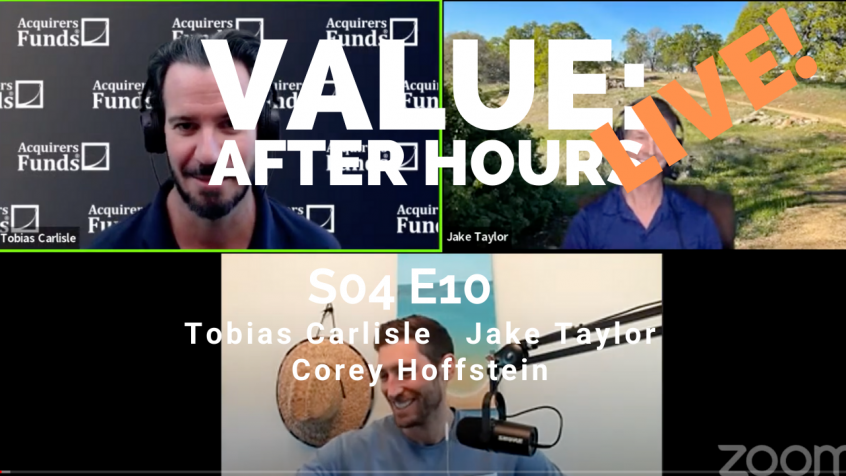In their latest episode of the VALUE: After Hours Podcast, Taylor, Hoffstein, and Carlisle discuss Flow Is Still Into Risky Assets. Here’s an excerpt from the episode:
Tobias: I don’t think we’re far into the volatility. If this is a mega bear, who knows? It could be. That’s a possibility. It’s not necessarily either. It could easily just bounce from here and we get back to normal. But if it is, then probably don’t want to shoot you what to. That’s the problem, you’re stuck in this– You should be roughly fully invested now in all the good names and then proceed down another 20% or 30% just wear it all the way down.
Corey: Well, here’s a little stat for you guys, because I like to talk numbers. This comes from Goldman Sachs. What you’re seeing right now to that point, Toby, you don’t think the volatility is over is that talk is cheap right now. You look at all the indicators that would people measure sentiment and they’re incredibly bearish right now.
Tobias: Yeah.
Corey: That’s normally an indicator that we’re near the bottom, but what you’re not seeing is flow slowdown or turning negative– [crosstalk]
Jake: The back of the talk.
Corey: If you look at risky versus safe asset flow over the last four weeks, it’s still in the top hundred percentile since 2007.
Jake: Wow.
Corey: You look at global equity flow over the last 12 months, it’s near the top hundred percentile and global equity flow over the last three months. It’s near the top hundred percentile since 2007. You still just have a tremendous amount of money. To the point I made earlier about Ark raising $850 million, the flow is still into risky assets. I think that’s because not to say this is not a blaming on retail, but long only investors that are unlevered, they don’t get blown up. They just slowly capitulate on a rolling basis, right?
Tobias: Yeah.
Corey: They can keep buying in and buying in. Again, Ark is round tripped. Its net lost investors’ money on a dollar weighted basis, but people continue to pile in, because they believe in the thesis. I’m not saying it’s right or wrong on what they do. But what you are seeing from a behavioral perspective is the sentiment and what people’s actions are could not be further apart or perhaps people think, “Oh, I know the thing to do when sentiments low it’s to buy.”
Jake: Yeah.
Corey: Now it’s the game theory of like, “Oh, no, everyone knows to do that. So, it can’t be the bottom.”
Jake: Yeah.
Tobias: Well, I talk about a little bit with the Fear & Greed index. I always think it’s an arbitrary construction of that index. That’s why someone was chipping me for saying it’s a nonsense index.
Jake: [laughs]
Tobias: It is a nonsense index, but in a short-term basis, it’s it has seemed to be reasonably predictive of the short-term bottoms. Because when it goes below 20, that seems to be a good time to buy. But I always put the caveat on that we don’t know what it looks like through a 2007, 2008, 2009 type scenario, because the index starts in 2010 and we haven’t had a mega bear since 2010. So, we don’t really know what happens to that sentiment. I would love to know. Does it go negative? I’ve got no idea.
Jake: Yeah, that’s the thing, it’s calibrated on. You get down to below 20, but that 20 on a more historical adjusted basis is 80. [laughs]
Tobias: Do you think it’s something like the Michael Green thesis, Corey to that flow thing that you’re talking about before where basically, there’s so much passive flow?
Jake: Yeah. How does indexing fit into all this?
Corey: Yeah, I’m not Michael Green. I can only speculate. Yeah, I don’t know. I will tell you, again, a lot of sell side notes that have come out in the last couple of weeks are talking about quarter end rebalancing, where you’re probably going to see selling down of bonds, and buying of equities, and target date strategies, and global target risk portfolios that knocks into equities that are held within the index versus not during those rebalance periods. You tend to see in equities within the index outperform equities outside the index. So, there are some like short-term knock-on effects of that stuff, but I think– [crosstalk] Have we seen that recently?
Tobias: Well, one of the simplest indicators, I think, is just the equal weight index versus the market cap float adjusted weight that the index that we all know and love.
Corey: This is more like S&P 500 versus Russell 1000. Like, a lot more target date stuff includes the S&P 500 versus the Russell 1000.
Tobias: Okay.
Jake: Not equal weight within. Yeah, to your point, “Is it all going to large cap flow? Is it helping sustain large cap?” I don’t know. I think it’s an interesting question of like, as a nation, we have turned the market into a savings vehicle every two weeks with 401(k) plans. Does that change the dynamics of where things were in the 2000s? Consider the fact that in the 2000s, target date funds were a sub $10 billion industry and now, they’re close to $3 trillion.
Jake: Jesus. It’s good marketing? [laughs]
Corey: How does that change dynamics of the world, where you’re now literally forced savings is flow into the market supporting equities?
Jake: With demographic glide path built in.
Corey: Right.
You can find out more about the VALUE: After Hours Podcast here – VALUE: After Hours Podcast. You can also listen to the podcast on your favorite podcast platforms here:
For all the latest news and podcasts, join our free newsletter here.
Don’t forget to check out our FREE Large Cap 1000 – Stock Screener, here at The Acquirer’s Multiple:




